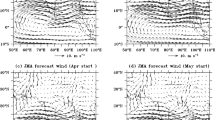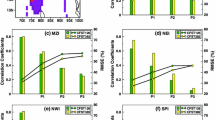Abstract
An economical explicit scheme of time integration is implemented in a regional model over Indian region to achieve computational economy. The model is also integrated by explicit Leap-Frog Scheme. The performance of economical explicit scheme is evaluated by comparing the forecast results with those produced by leap-frog scheme. The results show that the economical explicit scheme produces more or less similar forecasts as compared to those produced with leap-frog scheme. However, application of the economical explicit scheme saves substantial amount of computer time. The scheme is found nearly four times economical as compared to explicit leap-frog scheme.
Similar content being viewed by others
References
Arunkumar (1989), A documentation of FSU limited area model, FSU report No. 89-4, February 1989. Department of Meteorology, Florida State University, Tallahassee, Florida-32306, USA.
Asselin, R.A. (1972), Frequency filter for time integration,Mon. Wea. Rev.,100:487–490.
Das, P.K. and Bedi, H.S. (1978), A numerical model of the monsoon trough,Monsoon dynamics(Cambridge University Press), 351–363.
Das, P.K. and Bedi, H.S. (1979), Numerical simulation of monsoon circulation,Proc. Indian Acad. Sci. (Engg. Sci.),2: 17–27.
Gadd, A.J. (1978), A split-explicit integration scheme for numerical weather prediction,Q.J.R. Meteor. Soc.,104: 569–582.
Gadd, A.J. (1980), Two refinements of split-explicit integration scheme,Q.J.R. Meteor. Soc.,106: 215–220.
Kwizak, M. and Robert, A.J. (1971), Semi-implicit scheme for grid-point atmospheric models of the primitive equations,Mon. Wea. Rev.,99: 32–36.
Mohanti, U.C., Paliwal, R.K., Tyagi, A. and Madan, S.C. (1990), Application of split-explicit time integration scheme to a multilevel limited area model and forecast performance over Indian region.,Mausam,41: 531–540.
Robert, A.J. (1969), The integration of a spectral model of atmosphere by the implicit method,Proceedings of the WMO/ IUGG Symposium on Numerical Weather Prediction, Tokyo, 26 Nov.–4 Dec., 1968. (Japan Meteorological Agency, Tokyo, March 1969), pp. VII19-VII24.
Robert, A.J., Henderson, J. and Turnbull, C. (1972), An implicit time integration scheme for baroclinic models of the atmosphere,Mon. Wea. Rev.,100: 329–335.
Sasaki, Y.K., Ray, P.S., Goerss, J.S. and Solitz, P. (1979), Incosistency finite differencing errors in the variational adjustment of horizontal wind components,J. Meteor. Soc. Japan,57: 88–92.
Singh, S.S., Vaikya, S.S. and Rajagopal, E.N. (1990), A limited area model for monsoon prediction,Adv. Atmos. Sci.,7: 112–126.
Tatsumi, Y. (1983), An economical explicit time integration scheme for a primitive model,J. Meteor. Soc. Japan,61: 269–289.
Author information
Authors and Affiliations
Rights and permissions
About this article
Cite this article
Bandyopadhyay, A., Singh, S.S. Evaluation of forecast performance of an economical explicit time integration scheme in a limited area model over Indian region. Adv. Atmos. Sci. 11, 101–110 (1994). https://doi.org/10.1007/BF02656999
Received:
Revised:
Issue Date:
DOI: https://doi.org/10.1007/BF02656999




